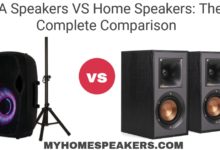Having your home speakers hung can prove to be a tough cookie most times, some individuals find it unnecessary but if you want to attain a life-like acoustic in your room, having your speaker placed on a wall over the listening area is a fantastic idea.
As this article proceeds, you will learn how to hang your home theater speakers and the type of loudspeakers that need to be hung to get the best sound quality and performance.
Table of Contents
Placement: how to hang home theater speakers
How your home speakers in a home theater system are positioned can be split into two main sections which are the back and front.
This is mostly the case for traditional sound systems like 7.1 systems. In the front area, you have a center and two front speakers.
Whatever music in the film is played back by the left and right front speakers, this is why they are positioned like a stereo pair.
The responsibility of emanating loud and clear dialogue rests solely on the center speaker.
The speakers behind and to the sides of the listening environment are referred to as surround speakers; they are also called “rear effect speakers” or “rear speakers”.
With these speakers, you get a spread-out sonic ambiance that delivers a cinematic experience.
There are different ways of setting each speaker up since they perform different functions:
- Your front speakers should be placed at least at 40cm high and not beyond 120cm from ground level if they are compact satellite speakers. In the case of tower speakers, they will be at the appropriate height by default.
The center speaker should be hung directly beneath or over the television set. You should place the three speakers strategically so that the sound they emanate travels directly to or around whoever is in the room.
- The ideal surround speaker height is around 140cm to 210cm from the ground level very much higher than the suggested height of the front speaker which should be situated around the listener’s ear level to properly maximize the sound.
This applies to the four surround speakers a 7.1 setup has and also the two a 5.1 surround system has.
How To Hang Your Wall Mounting Speakers
In the case of wall mounting speakers, compact are your best bet whether for your sound system’s front and back area.
Tower speakers which are mostly utilized for the front area are manufactured strategically that makes their sound permeates around the ears of anyone seated in the room.
If you are using compact speakers they are mostly positioned on the low board on the speaker stands or alongside the television.
Most times, center speakers are positioned mostly on a low board directly in front of a television.
You can wall-mount the two front and center speakers with wall-mounted televisions. It is ideal to hang smaller rear speakers as it is important to elevate them at a place behind the position of the listener.
Whatever speaker you decide to hang on a wall, we have two main methods to execute it:
- Directly Attaching The Speakers To The Wall: If you have compact and satellite speakers with keyhole brackets behind them then this is tailored to you. You fix screws into your wall and fit the keyhole brackets on them to hang your speakers.
- Hanging Them Via Wall Brackets: You must first have wall brackets fitted to your wall before placing the speaker into the bracket. There is a high chance to purchase brackets specifically designed for certain speaker types making it seamless to fit them into the brackets.
Wall brackets are preferable when compared to mounting your speakers directly on the wall because several wall brackets allow you to angle the speakers to the perfect position.
This angling situation may not be a necessity but can be convenient mostly when you have the speakers hung high beyond the listening position.
The opposite of the rule for the front speakers applies when it involves placing the rear speakers with the consideration of the listener’s position.
The right front left, and center speakers should, however, be angled towards the listener while the rear speakers create a bubbly, naturalistic ambiance by having their sound directed towards the walls.
The result of this placement is a sound performance that is not localizable. What it connotes is that it gives your sound system gives you live cinematic experience in the comfort of your home.
We have some specially designed surround speakers known as dipoles that give a diffuse effect by diverging the audio in two adjacent directions.
The most basic designs include a speaker membrane that moves sound forwards and backward without a sealed cabinet for the opposite side to be contained: they call it an “open baffle” design.
Wall brackets are quite effective with dipoles because they create a gap between the speaker and the wall which causes the dispersion of sound to improve.
Note: Just placing your home speakers on shelves may look like a more appealing solution, but it comes with a plethora of demerits.
When you place speakers with bass reflex vents and subwoofers on shelves it can cause unwanted resonances.
In several scenarios, most people do not have bookshelves with the appropriate height to properly place surround speakers and they will make it difficult to properly angle the speaker.
How To Hang Your Speakers On Your Wall Without Drilling Holes
As I mentioned earlier, having your speakers hung on the wall and angling it right can improve the overall sound performance of your home-theater experiencing while effectively managing your apartment space.
To have them hanged, several speaker brands have designed their speakers with pre-drilled keyholes or built-in hangers.
Some landlords, however, do not permit the walls of their apartments to be drilled to have speakers hung on them or any purpose whatsoever, so what do you do?
You can make use of large, photo frame hooks to mount your speakers without having boreholes.
To keep away from damaging any property, opt for picture hooks that can carry the weight of your speakers.
- Look for a surface that is not coarse to hang your speakers. The hooks of photo frames will not work well with coarse surfaces like textured or fabric paint and brick.
- Endeavor to use alcohol to thoroughly wash the area with a clean rag. Rubbing it with alcohol will get rid of dirt and grease that may interfere with adhesion. Make sure the area is dry before you continue.
- Detach the adhesive from the back of one of the photo frame hooks. Have it pressed carefully and firmly on the clean area of the wall?
- Now you can hang your speaker on the nook, and endeavor the speaker’s weight is not more than the nook can carry.
- Carry out the first four steps for every other speaker you need to hang on your wall.
Speaker Mounts That Help You Hang Your Home Speakers
Aside from hanging your speakers with their pre-drilled holes directly on your apartment walls, there are several speaker mounts designed specifically to make the process of elevating and positioning your speakers for an overall quality sound performance.
These speaker mounts were designed not only for hanging portable speakers (the ones most individuals hang) but to also make it easy to hang speakers that were not designed to be hanged.
Side Speaker Mounts
These are speaker mounts built specifically to be aligned to your television’s main mount and clutch your speakers to your television’s side.
Side speaker mounts can be adjusted to hold speakers of different sizes as well as televisions.
One prominent feature of these mounts is that whenever you want to move your television the mounted speakers change position with it due to being attached to it; this saves you the stress of having to move your speakers separately are repositioning them to get that perfect sound distribution.
Center Channel Speaker Mounts
These speaker mounts are specifically designed to keep your center channel speaker right beneath your television.
The center channel speaker mounts can be utilized with the main mount of your television and can be moved with your television maintaining the perfect position of the central speaker.
The fact that it can be moved with your Tv is quite imperative because one of the main workhorses of your home theater system is the central channel speaker.
Ceiling Or Wall Speaker Mounts
These speaker mounts are built to be installed from the ceiling or on the wall. You can permanently fix them in a place (making it necessary to be meticulous in your installation) or you can make them adjustable (the adjustable mounts are known as swivel and tilt mounts) so you can afford to project and aim for the perfect sound you desire. You can use different varieties of speakers on these sorts of mounts.
Final Thoughts
Having your speaker placed in the perfect position in your home can make a huge difference in your overall sound experience, and knowing how to hang these home theater systems mean you have the ability to place them in your apartment as you see fit.




